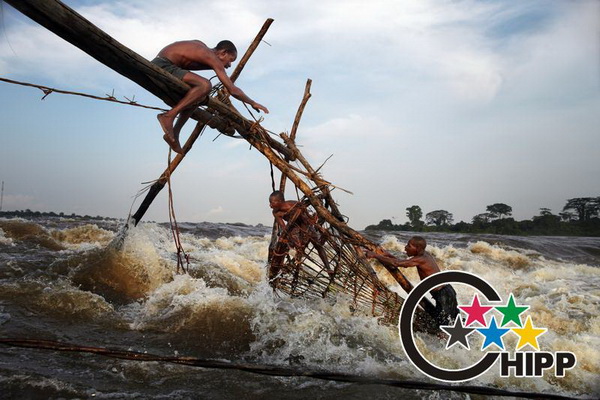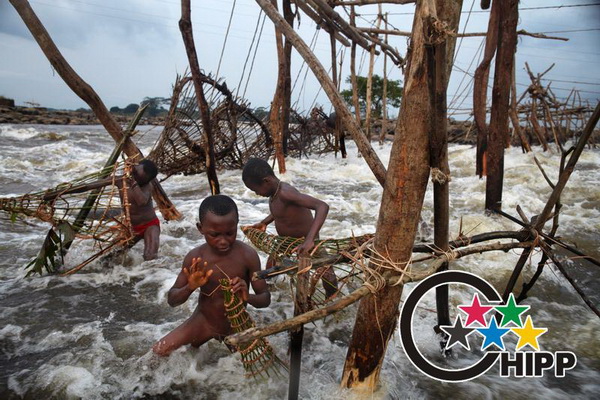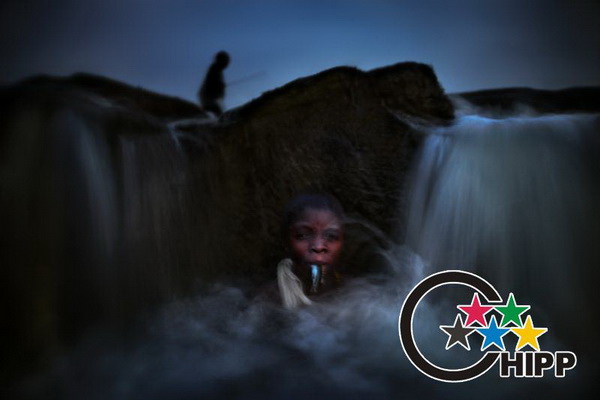|

|
|
|
第七届国际新闻摄影比赛(华赛)获奖作品
自然及环保类新闻组图获奖照片(银奖)
捕鱼 The Cataracts
帕诺斯图片社 Panos Pictures 安德鲁 麦康纳尔 Andrew McConnell |
1846年,探险家亨利-莫顿-斯坦利第一个踏上卢瓦拉巴河流域并发现了现在的民主刚果共和国当地居民的一种独特的捕鱼方式。他们在湍急的水面上搭建木架,编制巨大的木篮捕鱼。
In 1876
the explorer Henry Morton Stanley first encountered the Lualaba River in what is
today the Democratic Republic of Congo. While traveling along the Lualaba
Stanley encountered the cataracts, a series of seven rapids stretching over
100km and around which he was forced to drag his boats while continuously facing
attack from the Wagenia tribe. Stanley named the cataracts Stanley Falls and was
to found the settlement of Stanleyville after the last cataract, where the river
once more became navigable and where at last it became the Congo River.
Stanleyville was renamed Kisangani in 1966 and today is one of DRC's largest
cities. Stanley Falls is now Boyoma Falls and from Kisangani's bustling banks it
is possible to look upstream and see a raging line of whitewater; the seventh
and last cataract, which Stanley called a 'tumultuous rush'. Arriving here in
1877 Stanley described the method of fishing used by the Wagenia people, whereby
they would climb out over the rapids on wooden frames and use wooden baskets to
catch fish. The scene has not changed in over one hundred and thirty years.
2010年7月27日,渔民驾船前往位于刚果基桑加尼附近的博约马报瀑布的捕鱼点。
July 27,2010:Fishermen make their way to a series of
fishing posts in the middle of the Congo river at the last cataract of
Boyoma Falls, near Kisangani, DR Congo.
2010年8月4日:渔民检查位于刚果基桑加尼附近的博约马报瀑布的木篮。大部分木篮建在河边,但也有一些渔民会把木篮放在河中央,因为他们相信哪里水流最湍急哪里的鱼就会最强壮最大。
August 4,2010:Fishermen check their baskets at Wagenia Falls
in the middle of the Congo River, near Kisangani, DR Congo. Most of the
wooden frames are built near the river's edge but some of the fishermen
build frames in the very center of the river were the flow is greatest
as they believe this is where the strongest, and biggest, fish live.
2010年7月28日,渔民检查位于刚果基桑加尼附近的博约马报瀑布的木篮。
July 28,2010:Fishermen check their baskets at the last
cataract of Boyoma Falls, near Kisangani, DR Congo. The Boyoma
Falls, known as Wagenia Falls by the local tribe of the same name,
consists of seven cataracts spread over 100km, with the river
dropping 60 meters and finishing at Kisangani.
2010年8月3日,渔民操控这位于刚果河左岸的木栅。
August 3,2010:Fishermen navigate wooden frames over
Wagenia Falls (or Boyoma Falls) on the left bank of the Congo
River, near Kisangani, DR Congo.
2010年7月28日,渔民在检查位于刚果基桑加尼附近的博约马报瀑布上的木篮。
July 28,2010:Fishermen check their baskets at the last
cataract of Boyoma Falls, near Kisangani, DR Congo.
2010年8月8日,渔民在检查位于刚果基桑加尼附近的博约马报瀑布上的木篮。
August 8,2010:A fisherman checks a basket at Bamanga on
the Lualaba River (Upper Congo River), 100km upstream
from Kisangani on the Boyoma cataracts, DR Congo.
2010年8月3日,儿童在查看他们父辈曾经用过的小型木篮。
August 3,2010:Children check small versions of the
bamboo baskets their fathers use, at Wagenia Falls
on the left bank of the Congo River, near Kisangani,
DR Congo.
2010年7月29日,一位小女孩在刚果基桑加尼瓦格尼亚瀑布附近的低水位处捕鱼。
July 29,2010:A young girl takes advantage of the low
water level, at the height of the dry season, to
fish in the small rapids of Wagenia Falls, near
Kisangani, DR Congo.
2010年8月4日,刚果河中部的瓦尼利亚瀑布。渔民从他们的篮子中筛选出其中一条巨大的鲤鱼。
August 4,2010:Fishermen remove a huge carp from one of
their baskets, at Wagenia Falls, in the middle
of the Congo River, DR Congo.
2010年8月4日,一名渔夫在位于刚果基桑加尼附近的博约马报瀑布中检查木篮。在这里捕鱼最大的困难就是应付强劲的水流,也就是在这里卢瓦拉巴河汇入刚果河。
August 4,2010:A fisherman checks a basket at Wagenia
Falls (or Boyoma Falls) in the middle of the
Congo River, near Kisangani, DR Congo. The
fishing here is some of the most difficult as
fishermen must battle the full force of the
flow, and it is here that the Lualaba River
becomes the Congo river.
|
|










